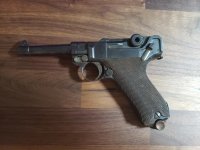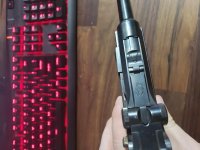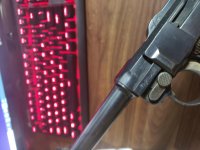It's a post WW1 'Commercial' (Non-Military contract or issue).
These are now commonly called 'Alphabet Lugers'
Originally the Commercial Lugers had their own serial numbering system that did not use a letter suffix. Just numbers.
It started with ser#1 in 1900 IIRC.
Commercial Luger ser#'s are stamped in some different positions on the pistol than Military contract Lugers are marked.
It was explained to me this way:
In post WW1 Germany (1920?) the Commercial Luger production ser# approached 6 digits,,that # of digits would not fit on the front edge of the Luger frame. 5 was the max.
They were in the ser#92,000 range when they decided to do something about the problem.
So it was decided that they would adopt the Military numbering system to the Commercial Lugers. That being using a Letter suffix to denote the 5th digit (each 10 thousand lot)
Since they were up to 9 (90 thousand) at that point, they started the Alphabet Luger numbering system by using suffix letter 'i',,the 9th letter of the Alphabet.
They started the ser#'s of the that first Alphabet range at 2000.
So the first full ser# of the Commercial Alphabet Luger was 2000i
(The 'i' being stamped below the 2000 on the front face of the frame of the pistol)
The numbering system continued that way on thru the alphabet. When the DWM plant was shutdown for Luger production and the machines moved to the Mauser Works (1930?), Mauser continued the ser#'s in sequence from DWM production.
There's always a few odd numbered ones that pop up and there have been a few late production 5 digit Commercials (pre Alphabet) that are numbered slightly higher than the 92,000 switch over point. Never say never.
I can't see the suffix in the pic. It will be a small case script letter. That along with the ser# should be enable you to track down the yr/mfg. Perhaps even closer from someone on one of the Luger Forums or someone here more involved with that stuff.
If you search the net for 'Alphabet Luger' or Alphabet Luger serial numbers dates of manufacture',,something like that, you may find the info you need to date it.
I've got a Weimar Era Luger book that probably lists them but it's packed away somewhere. I'll see if I can find it.
The GERMANY marking on the left side was a commonly applied Export marking on pistols coming to the USA where there was a huge market.
Crown/N is normal commercial Nitro proof mark.
Side plate should be ser#'d on it's bottom underside edge. Visible w/o taking anything apart,,just look at the pistol upside down and at the side plate underside edge. Should have a (matching) ser#.
Bbl ser#'s on the underside near the frame along with a commercial Crown/N proof.
Might also have some #'s stamped there like 8.81 ect. That'd be the land dia of the bore if it is a 9mm cal. Probably will be something like 7.51 or close to that if a 30cal Luger.
Or just look at the hole in the end of the bbl.







